The Western a New Frontier in Art and Film
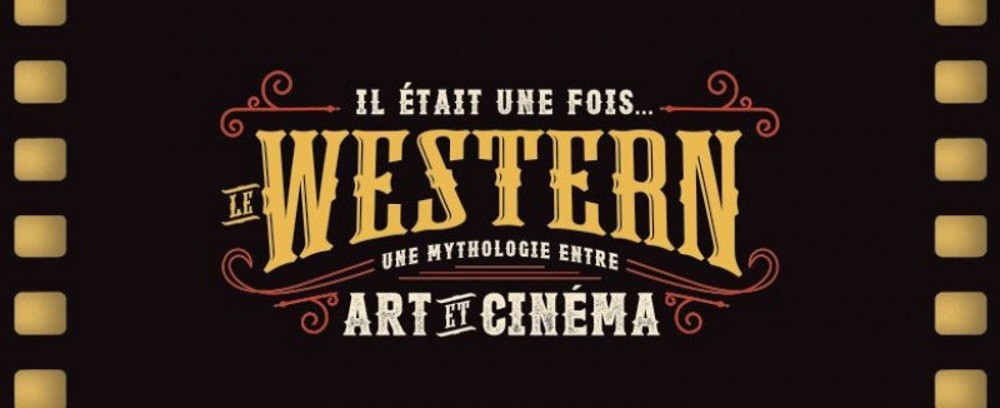
For fans of the virtually American of genres, the Western, I urge yous to get on over to the Museum of Fine Arts showroom on the Western, "Il Était une fois….le western: une mythologie entre art et movie theater" earlier it ends on Feb 4, 2018. The showroom is a joint effort between the Denver Fine art Museum and the Montreal Museum of Fine Arts and is a sprawling overview of the social, political, cultural and aesthetic touch on of the western on the psyche and imagination of a Nation. If you become to the showroom expecting a consummate revisionist account of the knottier issues tangled up with the western, issues of race, genocide, Manifest Destiny, Nationhood, yous might be disappointed. Which is non to say that the curators are oblivious to the more sensitive issues that make up the genre; in fact bug of colonial conquest and the terrible handling of Native Americans is cited and acknowledged throughout the exhibit. The exhibit goes out of its way not to injure the victims of Western expansion by being sensitive to linguistic communication and representation. For example, in ane text description accompanying a painting where an historical quote uses the term "Indian" it is followed by a parenthetical clause that alerts the reader that "Indian" is: "the word used to call Indigenous people in the day". Which made me realize that possibly nosotros have become and so sensitized to issues of representation that a very young patron of the exhibit may have never encountered that word, as hard as that might be to fathom from an older person'due south perspective. The exhibit does not shy from depicting the horrors of governmental policies tied to w expansion: the emptying of whole sustainable Indigenous tribes, demonization of Indigenous peoples and the shift of complex and suspicious Nation building into mythmaking. Notwithstanding, nosotros should keep in mind that equally the exhibit is being showcased in a museum of fine arts, the emphasis is placed on the impressive and varied body of art produced by American artists in flick, tv, painting, sculpture, literature and video.
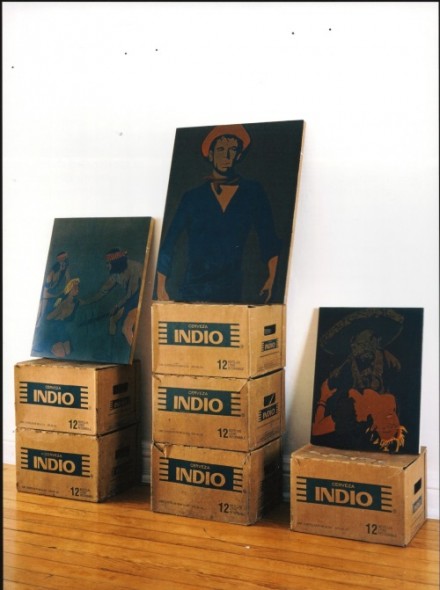
But while the injustices washed to the Native American peoples is represented, the exhibition downplays, following American Western movie house, the substantial lands lost past Mexico to the United States after the Mexican-American Wars (1846-48) during this same era of the western, culminating in the United mexican states Cession of 1848, where Mexico lost much of its land along the at present Mexico-U.s. border. Some of this omission is salvaged, indirectly at least, by the represented and decidedly more political Spaghetti Western, which in comparison to the American Western, has been more forthright in depicting the Mexican Revolution and the Mexican-American Wars. And contemporary Mexican artist Daniel Guzmán acknowledges this somewhat by alluding to the Spaghetti Western masterpiece The Expert, the Bad and the Ugly with his artpiece, "El Bueno, el Malo y el Feo" (The Good, the Bad and the Ugly, Mexico, 2005). Guzman pokes fun at the stereotypical delineation of Mexicans as brutes or drunks in American Westerns, but turns the tables by depicting the "savage Indians" every bit the "good" and the white sailor every bit the "bad".
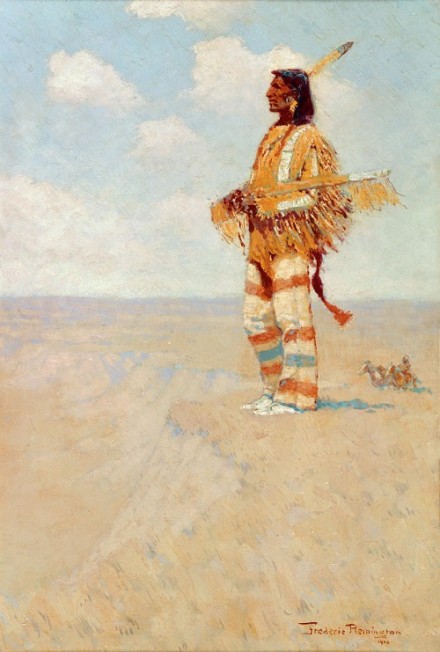
The Concluding of His Race (The Vanishing American), by Frederic Remington, 1908
The curators must take considered the possibility of a room showcasing Native American Western art, but decided against it, instead including Native American self-representations within the whole of the exhibit. So that the works of Wendy Red Star, Brian Jungens, Kent Monkman, Alan Michelson, Fritz Scholder, Adrian Stimson (aka Little Brown Boy Heavy Shield), Gail Tremblay and several unidentified Native American painters are interspersed according to theme or medium. In the catalogue the re-cribbing and artistic plow-a-circular of Western imagery by Native American artists is covered from a personal perspective by Plains Cree and Blackfoot curator, creative person, and author Gerald Raymond McMaster in the chapter "From Lone Ranger to Cigar-Store Prince" (p. 232-243). McMaster reveals how liberating it was to encounter Indigenous artists like Fritz Scholder challenging the "cowboy/Indian binary" (p. 240) at a time when the power of the Western was such that even he, equally an indigenous person, would root for the "skillful guy" cowboy!
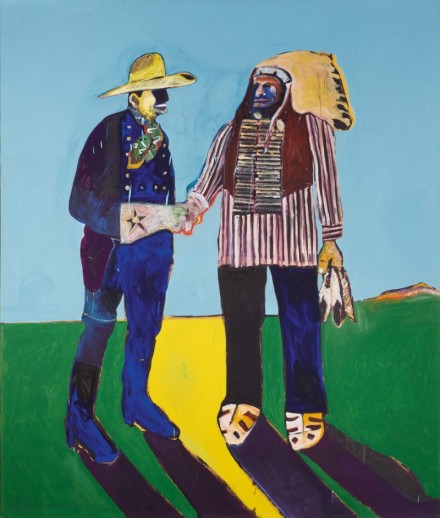
"Matinee Cowboy and Indian" past Fritz Scholder, 1978
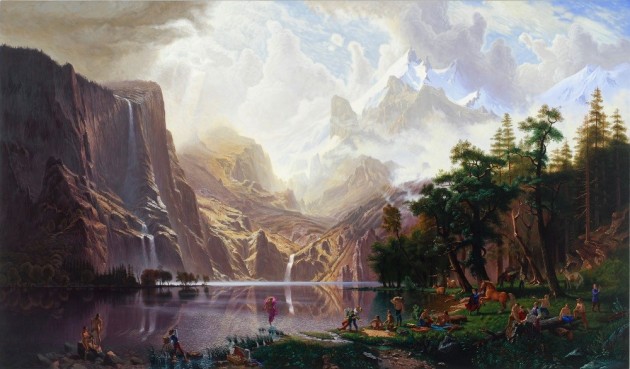
Queer Cree Canadian artist Kent Monkman re-appropriates Western colonial imagery in with homoerotic imagery in "The Trapper of Men" (2006)
Though the exhibit charts some standard terrain, like the hallowed spaces given to John Ford and Sergio Leone —and difficult to argue with that— there will besides be some lessons and surprises for the experienced or learned Western fan. It was exhilarating to see the range of art that was created around the Western imagination, much of it more than heavily steeped in realism than the films. More than well-known artists like Frederic Remington and George Catlin are well represented, particularly Catlin's many respectful portraits of Native figures, but as well lesser known figures, like a striking landscape painting "Emigrants Crossing the Plains" by Albert Biersadt (1867), where the oncoming promised land is depicted with glowing sunlight, while the Native Americans are symbolically framed well into the fading background.
,_1869_800_497_90.jpg)
The buffalo holds an important space in the exhibit, featured in a stunning painting entitled "A herd of Buffalo on the Bed of the River Missouri" by William Jacob Hays (1862), which depicts the once plentiful number of buffalo on the plains, with the sole ominous skull in the foreground a forewarning of the near extinction of the regal animal (encounter link beneath to view an NFB documentary on the saga of the great buffalo).
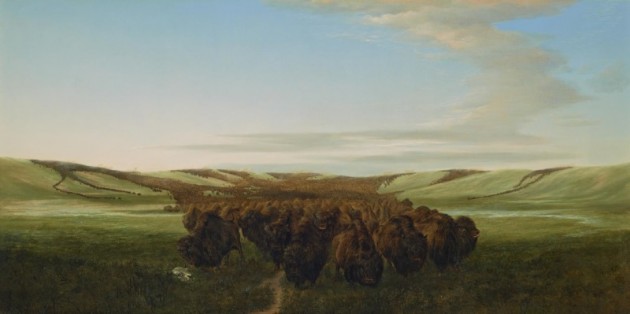
"A herd of Buffalo on the Bed of the River Missouri"
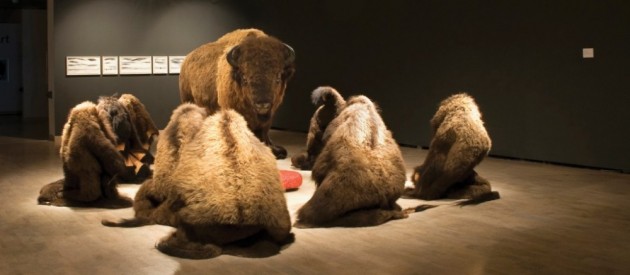
"Beyond Redemption", 2010
Another room is dedicated entirely to a life-sized hyper real looking buffalo sculpture, surrounded by buffalo hides. The sculpture transmits the staggering dazzler and majesty of the glorious animal that lived in perfect harmony with Native Americans before the inflow of the white human. The piece of work is function of a larger fine art series by Native American creative person Adrian Stimson called "Across Redemption" (2010) which takes as its theme the huge ecology and ecological impact of the nigh extinction of the buffalo. Along with paintings and photographs the exhibit also features some interesting onetime and gimmicky artifacts (clothes, teepees, weapons) and symbolic sculptures and modern video installations. Singing cowboys are represented through picture clips and accompanying paintings, similar "Cowboy Singing" by Thomas Eakins (1892), and women are represented with such real life figures as Cataclysm Jane and fictional tough women like Joan Crawford from Johnny Guitar and the positive "non-white" characters played past Mexican born actress Katy Jurado in High Noon, where she plays a strong female graphic symbol who ventures into male territory every bit a property-business concern owner, and the multi-ethnic Senora Devereaux in Cleaved Lance (1954, Delmer Daves). And I can tell past looking at the reaction of other attendees that I was non lone at being duped into thinking I was standing next to a patron past the highly realistic sculpture by Duane Hanson entitled "Cowboy (Blue Plaid Shirt)", circa 1984-1995.
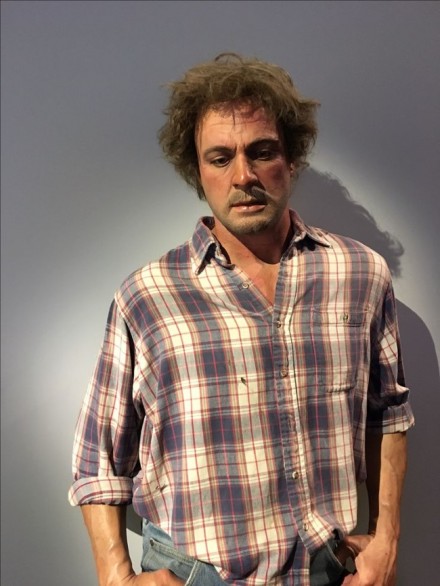
"Cowboy (Blue Plaid Shirt)"
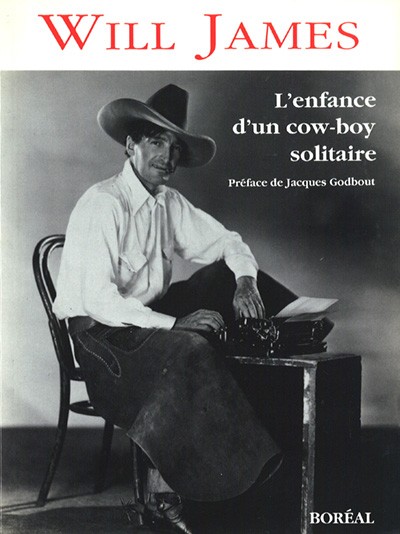
Alias Will James
The exhibit gives considerable space to the dwelling house of one of its hosts, with a space dedicated to the famous Quebec cowboy Will James, born in Quebec in 1892 as Ernest Dufault and the subject of a film by Jacques Godbout, Alias Will James. Reality meets fine art in some of William Notman'southward stunning portrait photographs, many of which were taken at his Montreal-based portrait studio in the belatedly 1800s. And a small roundish airtight off space in one of the final rooms is dedicated to a montage of clips taken from about ten Native American themed Quebec films.
I of the things I discover fascinating about the Western genre is that information technology represents a living history in its ability to offering space for reconciliation and a way to address the sins of the by. Even someone like John Ford consciously modulated his representation of Native Americans in a response to changing awareness and public perception of the conquest of the West. So that in Stagecoach (1939) the Natives are a marauding group of horseback riding savages out to ambush the stagecoach; and so in The Searchers (1956), while at that place is much to find problematic in the handling of the Native adult female equally comic relief, Ford acknowledges that the Natives are not savages but a people with a linguistic communication, culture, and spiritual conventionalities. John Wayne's Ethan Edwards stands with his nemesis Comanche chief Scar as an equal. They may both hate each other just there is respect for their respective obsessions. And then in his last western Cheyenne Fall (1964) Ford paints a sympathetic portrait of the Cheyenne Indians dispossessed from their land in Wyoming struggling to accommodate to Federal regulation and harsh Federal agents.
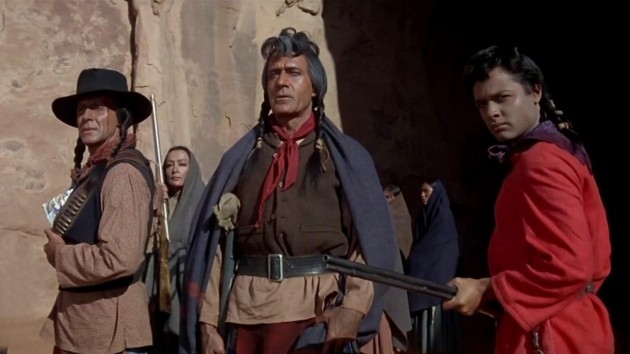
Cheyenne Fall
The exhibit gives over 2 big rooms to the period of more progressive American Westerns, offset from the 1950s (Devil's Doorway, Anthony Mann, 1950, Cleaved Arrow, Delmer Daves, 1950, Apache, Robert Aldrich, 1954) to the 1960s and 1970 Vietnam era westerns (The Wild Bunch, 1969, Sam Peckinpah, Soldier Blue, Ralph Nelson, 1970, Trivial Big Man Arthur Penn, 1970), including blaxploitation and feminist revisions of the Old Westward. The coverage of the counter-culture influenced Western climaxes with a corner of a room set aside for the original Harley Davidson (rebuilt after it was damaged) from Like shooting fish in a barrel Rider (Dennis Hopper, 1969), noting of form the ironic utilize of the American flag adorned gas tank and director Dennis Hopper's incomparably western tinged clothes. This 'borrowing' of Native American cultural signifiers past the young counter-culture hippies of the 1960s is covered in the catalogue past Michael Parke-Taylor'south commodity "Tribal Stomp"; while noted Comanche writer and an associate curator at the National Museum of the American Indian Paul Chaat Smith writes about the return to prominence of both the Western and the Native American in his chapter "The Improvement."
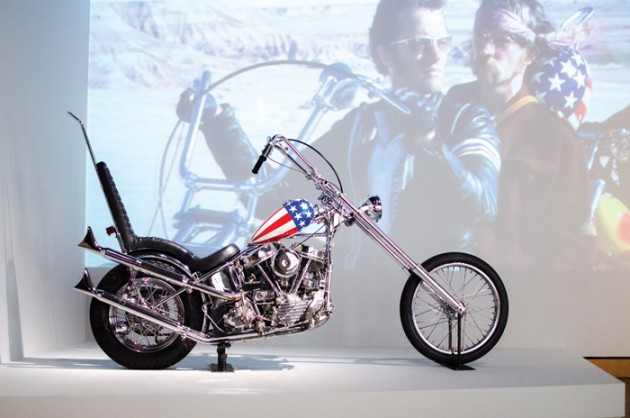
Easy Rider's "Captain America" Harley Davidson: Indians Become Cool
As someone who considers himself a flake of a Western junkie I notwithstanding gleaned quite a flake nigh the genre through the exhibit. And seeing the broad ranging fine art was stimulating and brought together Western pic into a larger continuum of influence and cultural value. For example, I learned through the details of a painting that the plot of The Searchers is based on a truthful story. Early in The Searchers Ethan Edwards' brother and family unit is slaughtered in a Comanche raid and his niece Debbie Edwards (played by Natalie Forest as a 15 year-old) is abducted and raised by the Comanche. This same act depicted in the film occurred in 1836 to a ten-twelvemonth former girl named Cynthia Ann Parker, who married a Comanche chief and lived for 24 years every bit a Native, raising iii children. The Texas Rangers reclaimed her to her white family as a 34 twelvemonth-old woman, but she tried several times in vain to return to her Native family and died a heartbroken woman in 1871. These details were given equally context for a striking creative representation of the white man's fear of miscegenation and Native rape of the white woman, in a painting entitled "Captive" by Eanger Irving Couse from 1891. The painting depicts a white woman lying unconscious outside a teepee, her bloodied easily evidence of a struggle she must have endured in her capture. A Native man sits rather solemn a few feet from her. Behind them the teepee's entry is suggestively left open up.
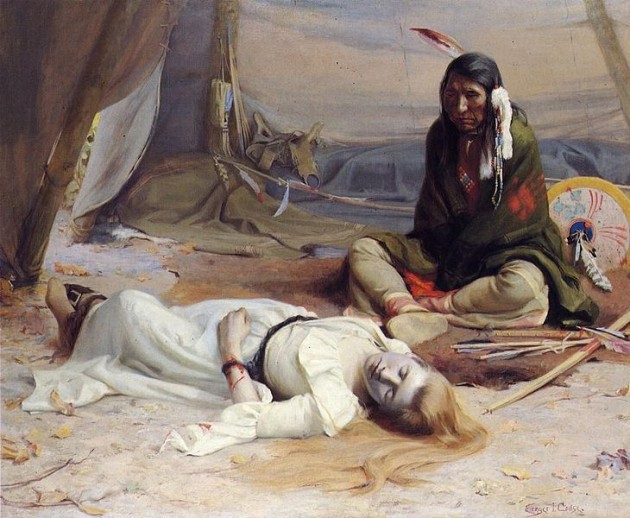
"The Captive" by Eanger Irving Couse (1891)
The painting, coupled with the story of Ann Parker, spoke direct to the themes that underscore John Ford's masterpiece, The Searchers: Ethan Edward's about psychotic reaction to the knowledge that his niece has been raped (or had sexual practice with) a Native man. Although Ford borrowed direct from the past, and the Parker events, his moving picture resonated equally with what was happening in American at the fourth dimension. 1954 likewise saw the landmark Supreme Court ruling in the Brown vs. the Lath of Educational activity hearing deciding that segregation in the school organisation was unconstitutional. The decision was instrumental in the eventual integration of schools in the South, even though many Southern Congressmen were vehemently opposed to the integration of schools. The Searchers deals with the notion of American identity in the context of White-Native, with the Jeffrey Hunter character Pawley chided by Ethan Edwards for being a "one-half-breed"; and Pawley himself aghast when he finds out he has been married to a Native woman (which leads to some distasteful comic relief at the expense of the Native woman, who is kicked out of a sleeping handbag by Pawley and sent tumbling down a hill). So even though The Searchers is directly about the Native-White identity issue, American viewers must have identified it directly or indirectly with the more current Blackness-White issues playing out in the courts and public discourse.
The ability of the Western to, as I say, raise profound bug of Nationhood and identity, and lay open the possibility of reconciliation, is why The Searchers (and westerns ongoing even today) has had such a profound impact on American film critics and filmmakers. The film has imprinted itself on directors like Martin Scorsese, Paul Schrader, John Milius, and George Lucas. There is no doubt that Scorsese dealing with his own identity issues equally a second-generation Italian-American related to the portrayal of Ethan Edwards and his obsessive hatred of Native Americans and his fright of American identity tainted by contact with non-Whites. In interviews Scorsese has said that when he offset saw the pic he read Edwards every bit a negative embodiment of the worse aspects of racism, even while acknowledging that Edwards —as portrayed past John Wayne— was a charismatic anti-hero. The power of The Searchers stretched into the avant-garde likewise, well-nigh notoriously with Scottish artist Douglas Gordon, whose installation screening at the 1995 Biennale de Lyon entitled "Five Twelvemonth Drive-By" projected the flick slowed down to five years, the aforementioned elapsing Ethan spends to rails down his abducted niece Debbie. In the catalogue we learn from Gordon that endless viewings of the motion-picture show on TV as a child led to his obsession with information technology.
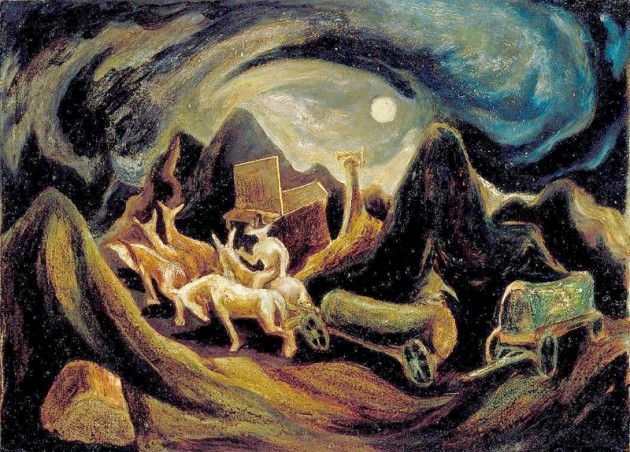
"Going W" Jackson Pollock (1935)
Many adjacent installations of paintings and film stills demonstrate with no incertitude the influence Western art had on filmmakers, notably John Ford who modelled his compositions on paintings past Remington, Charles Marion Russell, and Charles Schreyvogel. The exhibit brings this influence to life with stills from She Wore A Yellowish Ribbon, Stagecoach and The Searchers placed adjacent to their painting models.
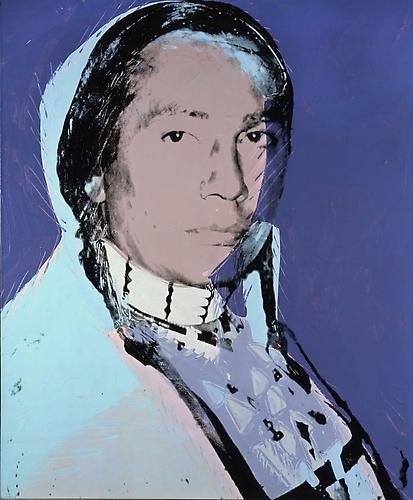
"The American Indian (Russell Means)" by Andy Warhol, 1976
A surprising parallel is made in the exhibit between the Western and the advanced, with Jackson Pollock and Andy Warhol singled out for their sometime rapport with the popular genre. While the link between Warhol and the western is more obvious or directly, with his 1968 gay-themed Lonesome Cowboys (long before Brokeback Mountain) and gun firing Elvis Presley painting ("Triple Elvis", 1963), the tie to Pollock is nimbler. The wonderful 300+ folio catalogue Once Upon a Time The Western, which comes with ample text and bountiful colour inserts, expands on the links between Pollock'south make of abstruse expressionism and the Western. Co-editor of the volume Mary-Dailey Desmarais makes a fascinating link between Pollock'due south action painting as a move to a psychological form of art that however makes use of the concept of landscape, and the tumultuous and psychologically troubled westerners (Western anti-heroes) plant in the films of Anthony Isle of man (exemplified by Jimmy Stewart and Gary Cooper), and other noir/post-war troubled western anti-heroes, similar the noted Ethan Edwards. "We might…think of Pollock's action on canvass as alike to the activity on screen of the lone cowboy who turns his back on the community, preferring the uncultivated ground of the American West" (p. 138). "More than than merely a space for action, however, the frontier in Western picture show and on Pollock'due south canvas was the site of the hero'south confrontation with his inner self" (One time Upon a Time: The Western, p. 138). Pop artist Roy Lichtenstein is likewise represented with his painting "Cowboy on Bronco" (1953). 1 of the more than hitting contemporary pieces in the testify is from Canadian mixed heritage (Swiss, Dane-Zaa) artist Brian Jungens and his sculpture "The Prince" (2006) which features a life-size Native fabricated from (mainly) the reformed leather of baseball gloves. Once over the shock of seeing a human made from baseball gloves, and named after Machiavelli's famous book, y'all begin to call up about the process and wonder, why baseball gloves? Perhaps the gesture is to satirize the National Pastime and North American sport teams that nevertheless cling to harmful names (The Atlanta Braves, The Cleveland Indians, Kansas City Chiefs, Washington Redskins, Chicago Black Hawks, etc.). Or peradventure it is a veiled innuendo to the "Cowhide" often used to make baseball gloves?
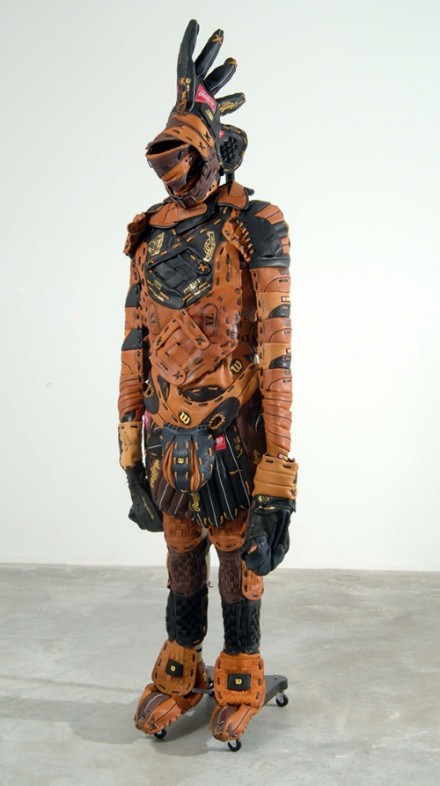
"The Prince" by Adrian Stimson
In the last chapter of the catalogue entitled "The New Golden Historic period of the Western" author Andrew Patrick Nelson speculates almost the future of the Western genre and offers the sobering verdict that the Western "isn't coming dorsum" (p. 274). Significant that information technology will never return to its glory days, when there were more Westerns being made than any other genre. But whereas in today's landscape the numbers are Westerns being made in relation to other genres is downwards, the reputation and scope of the Western is greater than ever. The mythology of the Western is so securely ingrained in the psyche of the American people that its influence has spread wider than the classic Western. "Identifying traces of the genre in contemporary popular culture is one way of asserting that the Western however matters" (Nelson, 277). Nelson cites the wide spreading work of Joss Whedon, who makes hugely pop films and TV shows that ally comedy, science-fiction, horror, musical, fantasy and action, simply underneath information technology all is the Western as THE grand narrative. I always figured Whedon for a fan of the Western just Nelson's chapter explains one major reason why. As a student at Wesleyan University in the 1980s, Whedon took classes with Richard Slotkin, one of the pre-eminent American scholars of the Western. Writer of such primal books as Regeneration Through Violence: The Mythology of the American Frontier 1600-1860 (1973) and Gunfighter Nation: the myth of the frontier in twentieth-century America (1992), Slotkin acknowledges his affect on Whedon: "I think he picked up on and shared my engagement with the Western as an American chief-narrative" (277). And Whedon concurs, "[Slotkin] has decoded and defined the American mythos more completely and clearly than any living soul. His Western film class set roots in all my works. I try to make scientific discipline fiction, simply ever stop upwardly making a Western" (277).
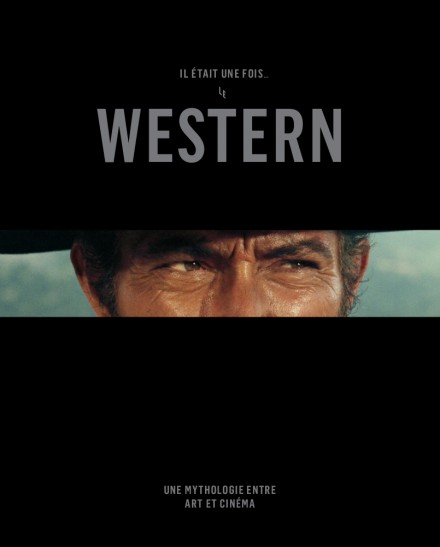
Exhibition Catalogue
Nelson argues that nosotros are currently in a Golden Age for the Western not only because of how high its stock has risen, or considering we can sentinel practically whatsoever Western we want at the click of a button, but considering of how broadly information technology has seeped into all forms of popular civilisation, from books, to comics, to animation, to tv and to feature picture. Western themes nigh Nation building, National identity, race and assimilation, Civilization and Wilderness, quest narratives, Individualism, and Redemption through Violence continually crop up in gimmicky Westerns and neo-Westerns, films set up in the present (or futurity) that play these familiar themes out in a modern environment. Like Dearest Wendy (Thomas Vinterberg, 2005), The Nighttime Valley (Andreas Prochaska, 2014, Austria/Germany), Sukiyaka Western Django (Takashi Miike, 2008), The Rover (David Michod, 2014), No Man'south Country (Ning Hao, China, 2014), No State For Old Men (Coen Bros, 2007), Gran Torino (Clint Eastwood, 2008), The New World (T. Malick, 2005), The Three Burials of Melquides Estrada (Tommy Lee Jones, 2005), Brokeback Mount (Ang Lee, 2005); or that are played out in a pre-mod or Western setting, such as Valhalla Rising (Nicolas Winding Refn, 2009), The Assassination of Jesse James by the Coward Robert Ford (2007, Andrew Dominik), There Volition Be Blood (Paul Thomas Anderson, 2007), and The Revenant (Alejandro Chiliad. Iñárritu, 2015). And the Western genre in a semblance closer to its classical brethren continues to draw both established auteurs, such as James Mangold (3:10 to Yuma, 2007, Logan, 2017), Kevin Costner (Open Range, 2003), Gore Verbinski (The Lone Ranger, 2013), Coen Brothers (True Grit, 2010), Quentin Tarantino (Django Unchained, 2012, The Hateful Viii, 2015), Tommy Lee Jones (Appalossa, 2008, The Homesman, 2014), Kristian Levring (Salvation, 2014, Kingdom of denmark), Antoine Fuqua (Magnificent 7, 2016) and younger directors, such as Logan Miller (Sweetwater, 2011), John Hillcoat (The Proposition, 2005), Gavin O'Connor (Jane Got a Gun 2016), Michael Fassbender (Slow West, 2015), JT Mollner (Outlaws and Angels, 2015, starring Clint's daughter Francesca Eastwood), Mateo Gil (Blackthorn, 2011, Bolivia/Spain), Thomas Makowski (The Virginian, 2014), and Kelly Reichardt (Meek's Cutoff, 2010). And equally I write this a Western entitled Hostiles directed by Scott Cooper and starring Christian Bale is being talked about as an Academy Award contender.
Call it the Whedon affect, but the Western is now the preferred genre with which to morph with another. As we can meet with Westerns that infringe heavily from the horror genre (Brimstone Martin Koolhoven, 2016, The Burrowers, J.T. Piddling, 2008, Os Tomahawk, S. Craig Zahler, 2015), comedy (The Skillful the Bad the Weird, Kim Jee-won, 2008, South Korea, Shanghai Noon, Tom Dey, 2000; Wild, Wild W, Barry Sonnenfeld, 1999); scientific discipline-fiction (Cowboys and Aliens, Jon Favreau, 2011, Westworld, TV series, 2016-); and super hero/comic volume (Jonah Hex, Jimmy Hayward, 2010, Renegade, 2004, Jan Kounen, France, Logan, 2017). Nelson gives an instance of but how wide spread the Western has become by citing a children's animated Western series that aired on Disney Junior channel that he watched with his 3-twelvemonth onetime son, entitled Sheriff Callie'south Wild West (2014) which is "nigh a female true cat who maintains law and society in the frontier town of Overnice and Friendly Corners". To quote Nelson, with all this happening around him, "If that isn't a Western golden age, I don't know what is" (278).
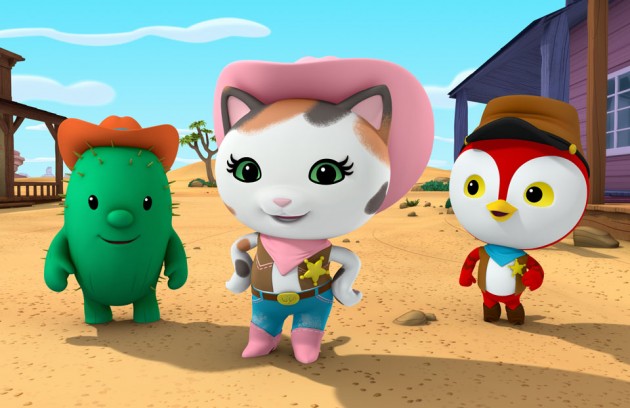
Western for children
Works Cited
Once Upon a Time…..The Western. ed. Editors Thomas Brent Smith, and Mary-Dailey Desmarais, 2017.
Watch the documentary The Great Buffalo Saga on the NFB.
Source: https://offscreen.com/view/once-upon-a-time-the-western-a-new-frontier-in-art-and-film

Post a Comment for "The Western a New Frontier in Art and Film"